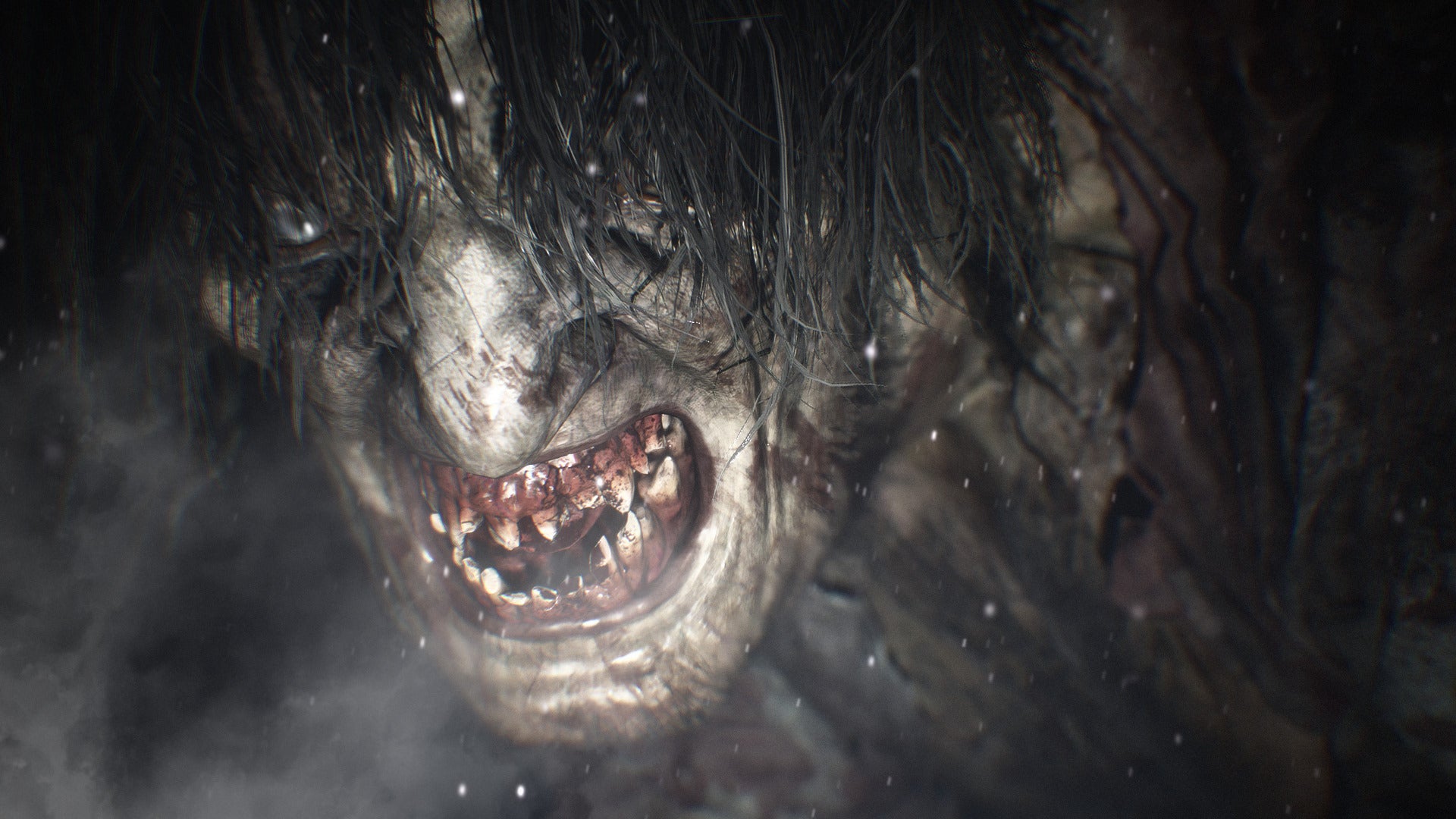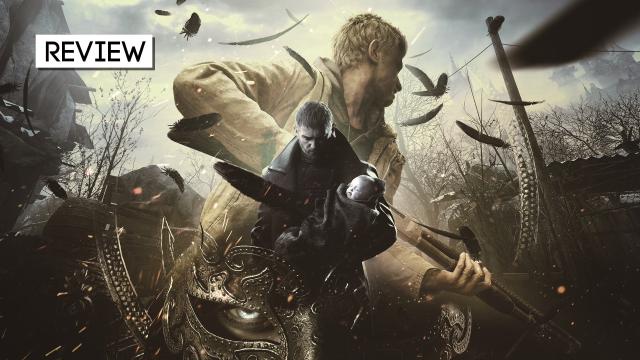I remember vividly the first time I played one of my favourite games of all time, Resident Evil 4.
While not what I would call a huge fan of the survival horror series before then, I voraciously devoured every bit of Resident Evil 4 info I could get my hands on leading up to its January 2005 release. My dad, who heard no end of my excited explanations of the story and mechanics, surprised me one day with a rental copy from our local Hollywood Video. I settled in that night to finally experience the horror myself, and after running into my first Dr. Salvador, called my friend over to play it with me. It was a huge moment, one that reignited my love for video games and, in hindsight, more than likely helped me find the path to my current career.
I take this self-indulgent trip down memory lane because Resident Evil Village — releasing this Friday for everything but Switch — feels like Capcom’s attempt at remaking Resident Evil 4 without actually remaking Resident Evil 4. Despite a lack of real scares and an over-reliance on action over horror in its third act, Resident Evil Village is everything I wanted out of a new Resident Evil game. Combat is hefty and brutal, the monsters are unforgiving and relentless, and the set pieces are compelling enough to make up for some inconsistent pacing and difficulty. Moment to moment, Resident Evil Village consistently surprised me with its dips and turns, the way that first trip through Resident Evil 4 did.
The franchise’s eighth main instalment in everything but name, Resident Evil Village directly follows the story of 2017’s Resident Evil 7. Ethan Winters, the everyman protagonist introduced in the previous game alongside its new, first-person perspective, has settled down somewhere in Europe with his wife Mia and baby daughter Rosemary, three years after surviving the swamps of Louisiana. Village opens with an intimate view of their new life together, but there’s a cryptic undercurrent of discord that cuts through their domestic bliss. The torture they endured at the hands of the mould-infected Baker family still looms large in their lives, a lingering trauma they can’t seem to shake.
Things take a turn before you’re given a chance to explore this dynamic. Someone riddles their home with bullets, and series mainstay Chris Redfield is revealed to be the orchestrator of the chaos. But this is a much different Chris than the one who contended with zombies in the original Resident Evil, punched boulders in Resident Evil 5, and most recently rescued the Winterses in Resident Evil 7. Grizzled and imposing, Chris shoots Mia and kidnaps Rosemary, leaving Ethan begging for answers.
While Chris played a small, surprising role in the previous game, his introduction as a foil to Ethan in the opening of Resident Evil Village acts as a microcosm for the franchise. The series began its life taking down shambling zombies in 1996, but the threats soon became much more over-the-top. As such, so did its playable characters. Chris, who was barely more than SWAT in a small Midwestern town when he first entered the Spencer Mansion all those years ago, has since evolved into a near-superhuman figure in the Resident Evil universe. A normal dude like Ethan was inevitable and necessary when Resident Evil 7 ultimately returned the series to its less action-oriented, survival horror roots.
Resident Evil Village forces you to wrestle with that history by placing one of these mythical ur-protagonists as opposition long before any monsters make the scene. Ethan has been through his fair share of danger, but it’s nothing compared to Chris’ now decades-long history of saving mankind from potentially world-ending threats. How do you overcome a man whose legacy has routinely escalated to the point of being supernatural? It’s a clever way of raising the stakes without immediately relying on a new, more fantastical bioweapon, and serves as a promising jumping off point for this new game.
It’s here that discussing the plot of Resident Evil Village gets complicated. In giving Kotaku a copy of the game ahead of release, Capcom has placed multiple restrictions on what we can say about the game’s boss battles, cutscenes, and overall story. While I understand the need to preserve the surprise for players, it also means I can’t yet discuss some of Resident Evil Village’s most creative and effective moments. The basics — that Ethan ends up in the titular village in pursuit of his daughter’s captors — have been a central part of the game’s marketing, but there’s lots to talk around when it comes to other details.
Ethan, confused and alone, is left to his own devices once he arrives in the village, allowing the player to get their bearings and explore a few of the abandoned shacks that make up the small community. The dated, dusty settlement feels like an obvious call back to the rural Spanish countryside of Resident Evil 4. It’s full of nooks and crannies, with several environmental clues that detail what life was like before tragedy arrived. Chickens and pigs wander aimlessly in untended pens, waiting to be butchered and used as ingredients in health- and defence-improving meals later on. Some areas remain hidden behind intricate locks, serving as brain-tickling reminders to come back and snoop around the hub area once the requisite keys have been found elsewhere.
When Resident Evil Village gets back to shooting bad guys, it proves itself to be just as competent as its predecessor. If you’re at all familiar with Resident Evil 7, you’ll be able to jump into Village with very little learning curve, but with a few minor changes. The ability to press the left bumper to defend yourself from melee attacks still exists, and this time around, pressing it a second time pushes the enemy away, opening them up to a quick headshot or shotgun blast. Furniture can be moved in front of doorways to avoid being overrun and packs of flour can be shot to obscure your movement. In fact, running away is sometimes the best option just to save ammo and healing items — even the game’s grunts, ferocious beast men known as lycans, can prove deadly if you’re not ready for their animalistic feints and charges. Enemies drop items upon death, a feature from previous games that was absent in Resident Evil 7, and its return makes combat even more of a balancing act, asking you to weigh using ammo and losing health against the potential for making more money or finding vital crafting materials.
[review heading=”Resident Evil Village” image=”https://www.gizmodo.com.au/wp-content/uploads/sites/3/2021/05/06/855dcd9e7209ccd5eb3644e5b384fc74.jpg” label1=”Back of the box quote” description1=”Ethan Winters’ European Vacation” label2=”Type of game” description2=”First-person survival horror” label3=”Liked” description3=”Similarities to Resident Evil 4, Donna Beneviento, weighty gunplay.” label4=”Disliked” description4=”The inevitable action-heavy conclusion, mostly uninspired bosses.” label5=”Developer” description5=”Capcom” label6=”Platforms” description6=”PlayStation 4, PlayStation 5 (played), Xbox One, Xbox Series X/S, Steam, Stadia” label7=”Release Date” description7=”May 7, 2021″ label8=”Played” description8=”11 hours on Standard difficulty, with lots of exploration, back-tracking, gun upgrades, and ingredient-gathering along the way.” ]
Every gun, from the basic handgun given to Ethan at the start of the game to more powerful fare like the grenade launcher, feels great to shoot, especially with the haptics and pressure-sensitive triggers of the PlayStation 5’s DualSense controller. There’s even a neat little thing where the right trigger becomes incredibly loose between uses of weapons with low fire rates, like shotguns and sniper rifles, with tension only returning when they are ready to be fired again. This provides some really fun moments during more hectic encounters: I lost track of the number of times I cursed at my controller because it wasn’t allowing me to shoot an approaching monster, replicating what it must feel like to have an actual gun jam up in real-life combat situations.
Another aspect of Resident Evil 4 echoed in Resident Evil Village is the ability to upgrade your weapons, both with attachments found in the wild and upgrades bought from the game’s new merchant, an enigmatic figure known only as The Duke. Money is just as precious as healing items, providing a separate, economic puzzling of whether to cash out on bolstering your ammo reserves or saving up to make your pistol a little bit stronger or quicker on the reload. I also very much enjoyed the return of the inventory management system, a pseudo mini-game where guns, ammo, and other items have to be organised in your attaché case, even if it doesn’t have all that much bearing on the overall game.
This all boils down to the chief conflict in the Resident Evil franchise (apart from, y’know, the monsters and stuff): making the most of a bad situation. So much of the ebb and flow of Resident Evil Village is the never-ending series of micro-choices that may have repercussions down the line. Ethan is constantly beset by danger, and it’s often up to you to decide which of the options presented to you is the least terrible. While it was rare for me to come up short on crafting materials to make ammo or healing items — thanks to an obsessive need to search everywhere before moving on with the story — there were late-game moments when I found myself anxiously relegated to using my sniper rifle in close combat. It was a kind of “whatever works” strategy that feels right at home in the crumbling, desperate world of Resident Evil and imparted me with some of Ethan’s own stress.

While the game’s care to reference the enemy sieges and gunplay of Resident Evil 4 makes it a consistently tense experience, Resident Evil Village just plain isn’t scary most of the time, perhaps intentionally. Making progress early on is often a matter of entering dark, creaky buildings while monsters scuffle and growl just out of sight, but my arsenal of weaponry soon became so powerful that, on standard difficulty, serious threats were few and far between. Village’s boss battles felt similarly underwhelming, mostly acting as chapter-ending bullet sponges with very little in the way of scares or strategy.
The only part of the game that really provided a fright was my visit to Donna Beneviento’s mansion — unfortunately, as I mentioned before, I’m not allowed to talk about that here. In fact, the last few action-heavy hours of the game are about as far away as you can get from the beginning’s attempts at survival horror. This escalation is a problem that even the modern era’s best Resident Evil games haven’t managed to solve, and it continues to be a disappointment whenever a new instalment rolls around. The series never quite manages to stick the landing, its compelling openings writing checks that the conclusions ultimately can’t cash.
Just a few years ago, Resident Evil 7 marked a return to the series’ survival horror roots, setting a high bar for its eventual follow-up. While Resident Evil Village still falls prey to the series’ most pernicious problems, notably the inevitable swerve from horror to action and bosses that don’t quite match the strong moment-to-moment gameplay, those shortcomings don’t overshadow the frequency with which the game hits on all cylinders. Village may not live up to the potential of its immediate predecessor, but it’s a safe new entry in the series that induces the same entertaining anxiety as my favourite Resident Evil games and provides a few interesting wrinkles for where the franchise might go next.

Leave a Reply